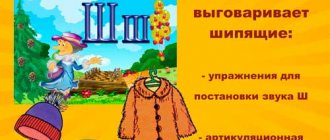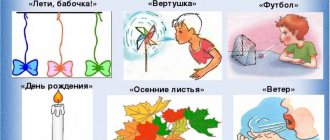Homework for the sound L for parents is developed comprehensively and contains numerous games and exercises. You can download these lessons from our website in one file (see below).
These are 20 lessons with various tasks:
- articulatory gymnastics for the sound “L”;
- automation in syllables, words, phrases, sentences, texts, poems;
- retelling and composing stories based on mnemonics and plot pictures;
- learning funny poems;
- repetition and memorization of pure phrases;
- interesting tasks on adventure games, coloring books, games and exercises based on our website logoped-online.by
Each lesson is located on 2 sheets of A4 format. You can print on two sheets, or on one - a page on each side. Total, 20 sheets - 20 full-fledged lessons for practicing the sound “L”.
The classes are developed based on our website logoped-online.by . On the site you will find colorful illustrations, mnemonic tracks, games and exercises to help with the printouts.
Instructions included.
Each lesson contains a set of articulation exercises for the sound “L”. At the beginning, all exercises are presented in pictures and with descriptions. Further descriptions are attached only to new exercises. Articulatory gymnastics exercises are necessary to prepare the speech apparatus, so do them. And your baby will speak faster!
In each lesson you will also find a lot of varied speech material . Pictures of the speech material can be found using the provided links or QR codes. You can log in from your smartphone using a special application. By following links or codes you get to the site and complete the same tasks, but with the help of pictures. All this is done in order to make classes as interesting and comfortable as possible for kids.
In order for the child to find it both interesting and at the same time useful, the classes are supplemented with numerous coloring pages . This is both visibility for the child and the development of fine motor skills of the fingers. Let us remind you that it is better to color with triangular pencils: they fit better in the child’s fingers.
And the main rule is to make sure that the child says the sound “L” correctly!!!
The website presents an abbreviated version of a set of lessons on strengthening the sound “L”. You can get the full version by writing to the email address
Sound correction [l] at home
Speech disorders occur for various reasons. In the case where the child does not speak only one or two sounds, parents can try to correct the defect themselves.
Classes with a speech therapist will help correct any speech problems
How to teach a child to say the letter L hard
With dyslalia, children have problems only with sound pronunciation. Violations arise due to structural features of the articulatory apparatus or insufficient muscle preparation.
For the sound [l], the upper rise of the tip of the tongue is important. This is difficult to do with a short hyoid frenulum. Therefore, it must first be trimmed by a dentist. Only surgery will solve this problem.
It’s easy to check the ligament: you need to ask the child to touch the upper teeth with the tip of his tongue. Sonoras ([l], [r] and their soft pairs) appear by the age of five and until that time there is nothing to worry about. At three years old, the child’s articulatory apparatus is still developing.
Important! There is no need to rush and demand that children pronounce all sounds from an early age. Otherwise, you can provoke the development of a defect.
At home, you can try to correct the incorrect pronunciation of the sound [l] yourself. This is only allowed in the case of dyslalia. Sometimes this problem can be confused with dysarthria, which requires work with a speech therapist.
With dysarthria, the mobility of the muscles of the articulatory apparatus is impaired. A similar problem is expressed in hypertonicity or hypotonicity. Often the tongue of such a child is bunched up in the mouth or is too relaxed. It will be difficult for your baby to perform fine movements and switch from one position to another.
Correcting incorrect pronunciation may take up to one year. You need to work with your child every day - this will speed up the process. It is necessary to follow the sequence of stages and not rush.
Sound production
The mechanical method is often used in speech therapy. It requires a special probe in the form of a wire frame or a spatula. The child opens his mouth wide, pronounces “YYYYYY” in a drawn-out manner, and at this time the adult lifts his tongue with an instrument.
It is easier to teach a child to pronounce a sound from the interdental position. To do this, the preschooler is asked to bite the tip of the tongue and pronounce the sound [s] (YYYYYYY), and then gradually remove the tongue behind the upper teeth.
You can pronounce [l] in the interdental position immediately with syllables. Gradually we are moving away from this situation. Automation begins only with direct syllables: LA, LO, LY, LE.
Important! You cannot rush to move on to words, otherwise defective pronunciation will become entrenched.
Breathing exercises for the development of speech breathing in children
Sound Automation
After the correct pronunciation has been worked out in forward and backward syllables, they move on to words. To facilitate perception, visual material is used in the form of pictures and special games. For example, a child is asked to show objects with the sound [l].
Syllables can be pronounced using a probe
It is difficult to teach a preschooler to exercise self-control. Therefore, you need to constantly work with him. It is enough to devote less than half an hour to work and the effect will not be long in coming.
Parents should understand that there is no method that will give quick results. Only constant training will help you consolidate correct pronunciation.
Songs and rhymes
To facilitate the automation process, different lexical material is used. Pure sayings and poetic forms are easier to remember and the child likes to reproduce them.
You can talk to a preschooler about different topics. This will make it easier for him to get used to the correct pronunciation.
Example of poems for sound automation [l]
The main condition for effective classes is the interest of the student. Therefore, everything is carried out in a playful way. The more varied the material, the better for the baby.
Tongue Twisters
The most difficult thing is to introduce sound into independent speech. To facilitate the process, tongue twisters using the sound [L] are used. They contain words that allow you to practice sound pronunciation in different positions.
For example, “There are pins at the Christmas tree”, “Will in the field”, “I went to Luka’s tray, Luka bought onions from the tray”, etc. Gradually, the child is asked to pronounce each tongue twister faster. Much attention is paid to correct pronunciation.
Articulation exercises
Learning to pronounce a sound correctly begins with articulatory gymnastics. Speech therapy exercises for quickly setting sound [l]:
- The wide tongue lies behind the lower teeth, the child pronounces “YYYYYYYY” in a drawn-out manner.
- Lick your upper lip with the tip of your tongue.
- Click your tongue.
- Open your mouth wide and run your tongue along the inside of your teeth.
- Run the tip of your tongue across the roof of your mouth.
The complex is performed every day. In order for a child to learn to pronounce a sound correctly, he must do all the exercises correctly. In this case, it is important to monitor the immobility of the jaw.
Articulation gymnastics is performed strictly in front of a mirror
After all the movements are easy to perform, move on to the next stage - producing a solid sound [l]. To do this, different techniques are used. It is impossible to say in advance which one will suit a particular child.
Correct articulation of the L sound
- The lips should be stretched into a smile and clenched teeth should be shown: this is necessary so that the hard sound “L” does not turn into “V” or soften.
- The tip of the tongue can occupy the following positions: it presses on the upper teeth; it can be pressed against the upper alveoli; it can rest against the gap between the teeth.
- The air is pushed out under pressure through the holes on the sides of the tongue.
- It is important that the tongue does not rest against the sides of the teeth, allowing air to pass through.
Classes should be conducted in this order
Before you start practicing, you need to practice pronouncing this sound according to all the rules in front of a mirror. It is likely that the child received a speech defect as a result of the incorrect pronunciation of the letter “L” by someone in the family.
The feasibility of speech therapy classes
Some parents do not think about how to teach their child to say the letter L. They do not consider the defect to be something serious, but in adult life it will become the basis of complexes and worries.
Important! It is better to correct speech disorders in preschool age, then the process will take a little time.
Complex of articulatory gymnastics in the senior group for children 5-6 years old
If parents do not know how to correctly teach their child to pronounce the letters L and R, then they should contact a specialist. A speech therapist will be able to correct this problem and develop the desired pronunciation.
How many lessons does it take to produce sound [l]
It is impossible to say with certainty how many lessons will be required to eliminate the defect. Sometimes sound production takes one session, in other situations it will take more than 30-40 meetings.
It all depends on the characteristics of the child, his motivation and the interest of the parents. Learning to pronounce the sound [l] is not so easy, since a preschooler gets used to a certain stereotype. Due to their age, it is still difficult for children to perceive learning activities.
How does an individual sound production lesson work [l]
The speech therapist performs sound production only after the student performs articulatory gymnastics well. The complex is performed strictly in front of a mirror. Afterwards they do breathing exercises and perform speech hearing tasks.
How does an individual lesson on sound automation work [l]
The speech therapist conducts individual lessons on automating the sound [l] only after calling an isolated pronunciation. At such lessons, the specialist develops the lexical and grammatical structure of speech, phonetic and phonemic hearing.
To do this, use different games and simulators. Modern speech therapists use computer games. Parents are required to participate in the process and carry out the specialist’s tasks at home.
Important! The duration of the lesson for preschool age is approximately 25 minutes. Physical minutes are required to switch activities.
Caution: physiological dyslalia
But by the age of four you need to be on your guard: the time for correct speech comes, and the baby simply does not know how to pronounce some sounds. And if you leave it to chance, and don’t teach him to speak correctly in time, you can make your child the subject of mockery and ridicule for the rest of his life. And he will probably have problems with spelling. Along with the difficult consonant “R”, many children do not know how to pronounce the letter “L”.
This speech defect is called physiological dyslalia in speech therapy and is quite common among children from four to six years old.
Types of pronunciation disorders
Over time, many people themselves can learn to speak correctly. This is how a child can distort the letter "L".
- The baby does not hear this sound and completely misses it: instead of “ruler” he says “frost”.
- “L” is replaced by the sound “U” or “V”: “spoon” - “oozhka”; "Larissa" - "Varisa". At the same time, children try to pronounce “L” not with the tip of their tongue, but with their lips
- Instead of “L” it is pronounced “Y”: “hammer” - “myotok”
- The child confuses the hard and soft letter “L”.
Before contacting a speech therapist, it is useful for parents to become familiar with the rules of pronunciation of the sound L and teach them to their child. Perhaps after home lessons he will begin to say this sound correctly.
EXERCISES FOR POSITIONING L
In the process of making the sound L, it is important to practice the correct position of the tip of the tongue. Special gymnastics to strengthen the articulatory apparatus, which should include the following exercises, will help you do this effectively: - “Parachod”. The exercise allows you to practice the correct position of the tongue for pronouncing L. In the starting position, you need to stretch your slightly open mouth in a smile, stick out your tongue as far as possible and, holding it with your teeth, make the sound “oo-oo-oo”. If you do everything correctly, you will get the sound of a ship's whistle; - “Turkey baby.” The exercise trains and develops the speed of the tongue and gradually develops its correct rise to the palate. To complete the task, you need to ask the child to imitate the turkey’s “bl-bl-bl” chatter. To do this, the baby needs to stretch out his tongue into his slightly open mouth, “hug” his upper lip with it and try to make several movements up and down with the tip of his tongue. As soon as you can perform the movements, you need to turn on the buzz and increase the speed of the tongue movement until you hear “bl-bl-bl”; - “Horse.” The exercise is performed in two stages - in the first, you need to teach your child to click his tongue, and in the second, imitate how a horse rides. Thus, the muscle tissue of the speech apparatus is strengthened and the skill of raising the tongue to the palate is formed. You need to work out different options for performing the exercise - with and without voice. To do this, you need to explain to the child that the horse can ride quietly, and try not to use your voice when performing the task; - “Breeze.” The exercise teaches you to create an air flow so that it goes along the edges of the tongue, and not in the middle. Starting position: mouth slightly open, the tip of the tongue is between the slightly pressed teeth. Then you should ask the child to blow lightly, imitating the flow of wind. To understand whether the exercise is performed correctly, you can bring a small ball of cotton wool to your mouth and track the direction of the air flow.
How to automate the sound [l']?
It’s better to start with a soft [l’], pronouncing the syllables “la”, “le”, “lyu”, then move on to the words: “earth”, “light”, “Lyuba”.
Pure sayings are useful (you can come up with them yourself), for example:
- Li-li-li, we found a berry.
- Lu-lu-lu, I'll water the cabbage.
Then we move on to the reverse syllables: “al”, “el”, “il”. With your child, compose words and phrases with these syllables: “tulip”, “chair”, “cartoon”.
We gradually add consonants: s, p, k, v, g, f (“klu”, “klya”, “kli”, etc.). We pronounce the words: “beak”, “oath”, “nickname”.
WHAT MISTAKES DO CHILDREN MAKE?
To correctly reproduce the sound L, you need to stretch your lips in a slight smile, touch the incisors of the upper jaw with the tense tip of your tongue and sound. Violation of the pronunciation of L is called lambdacism. In young children, two types of lambacism most often occur, namely: - interdental - the tip of the tongue is located between the teeth beyond the border of the upper jaw incisors. With this pronunciation, the result is something between V and L. The standard technique for producing the sound L will help correct the pronunciation with this violation; - nasal - the back of the tongue touches the soft palate, while the air flow passes through the nasal passage, which produces a sound similar to the combination of NG. In this case, instead of the phrase “happy horse,” the child will say “vesengaya ngoshdaka.” To correct nasal pronunciation, you will need regular speech therapy sessions and training in proper speech breathing. There are other variants of pronunciation of L, for example, paralabdacism (replacement of L with consonant G, D, soft L, etc.). Parents should pay attention to the following mistakes of children: - pulling the tongue towards the soft palate, which is why L sounds like Y (instead of “shop” the child says “yavka”); - pronunciation of the wrong sounds due to incorrect positioning of the lips (instead of “spoon” the child says “woo”); - incorrect distribution of speech breathing, for example, L is reproduced with a sharp inhalation, which is why the sound F is produced (together “flap” the child says “foskut”).
Recommendations for parents
Before moving on to exercises with the letter L, adults need to learn a number of simple rules that will make classes easy and spending time with your child enjoyable:
- Speak as equals. Don't try to make things easier by babying, you'll only make things worse. Pronounce all words correctly - this is an extremely important condition.
- Answer questions. If your child doesn’t understand something, stop and explain in more detail. This way your baby will feel strong support, and you will gain his full trust.
- Turn activities into games. Children learn information well through play. It is important that the exercises evoke a positive emotional response in the baby. Make up fairy tales and arrange unusual adventures. Under such conditions, the child will begin to pronounce the sound L reflexively.
- Exercise shouldn't be a punishment. In this way, you will discourage your child from wanting not only to study, but also to communicate with adults.
- Maintain regularity. Conduct classes systematically, at a time that is comfortable for you and your child. The ideal option is exercise for 5-10 minutes 3-4 times a day.
By following these simple recommendations, your child will quickly learn to pronounce the letter L at home.
Tale about the letter L
Little Fox and Little Frog
In the forest, in a large puddle, there lived a little frog who really loved to sculpt from clay. He crawls out of the puddle, picks up some clay and sits there sculpting. At first he only made flat cakes. Then he started making koloboks and lemons. Then he made an elephant and after that a lion on skis and a horse in a boat.
The animals looked, laughed and affectionately stroked the frog on the back. Only one little fox (was he jealous, or what?) came, broke everything, and even teased:
- Greenest of all is the big-eyed frog!
And this continued until the little fox grew up. One day he came to a puddle, sat down next to the frog, watched for a long time as he sculpted, and said sadly:
- I used to sculpt too, but I just couldn’t do anything... - Nothing! - said the frog. - Don't be upset! But you dig the most cunning holes.
(G. Yudin)
Poems about the letter L
The alphabet will continue with our Letter L - forest hut.
ΛΛΛΛΛ
L looks like a stepladder And the roof of a house too. Light Leaf Flew through the Forest, Didn’t Want to Land.
S. Ivanov
ΛΛΛΛΛ
The letter L came to visit us, Larisa found it for us, gave it to Lena, Alla, and did you recognize it?
ΛΛΛΛΛ
The letter L is such a sleepyhead, Yes, a well-known style, Everyone knows the word “laziness”, Walks, wanders, like a shadow, Puts sleep on people, Yes, closes everyone’s eyes.
ΛΛΛΛΛ
The frog healer is known in the forest; the frog treated the fox with a bow, and covered its paw with a rag. The elk was treated with lily leaf.
R. Gorenburgova











